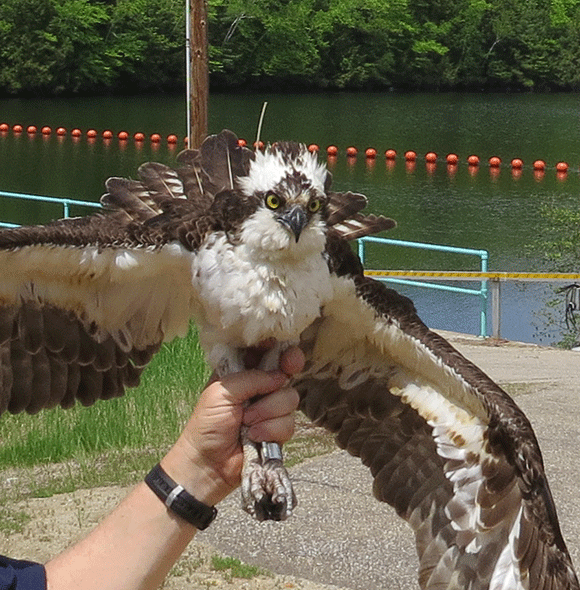 Gundersen. On the 19th of May we trapped at the Ayers Island Dam near Bristol, NH, in the middle of the state. This nest had been our nemesis. We tried two years to catch the male at this nest but were unsuccessful. This year the trapping went quite smoothly. We caught the female first--as is almost always the case--and held onto her while we waited for the male to take over on the nest. This is the same female we've caught twice before as we tried to trap males at this nest. After a pretty long wait, we got our bird. He was named Gundersen in honor of the former manager of the hydroelectric plant. Bob Gundersen was a big fan of the Ospreys and helped out with the old nest-cam that operated here. Gundersen. On the 19th of May we trapped at the Ayers Island Dam near Bristol, NH, in the middle of the state. This nest had been our nemesis. We tried two years to catch the male at this nest but were unsuccessful. This year the trapping went quite smoothly. We caught the female first--as is almost always the case--and held onto her while we waited for the male to take over on the nest. This is the same female we've caught twice before as we tried to trap males at this nest. After a pretty long wait, we got our bird. He was named Gundersen in honor of the former manager of the hydroelectric plant. Bob Gundersen was a big fan of the Ospreys and helped out with the old nest-cam that operated here. |
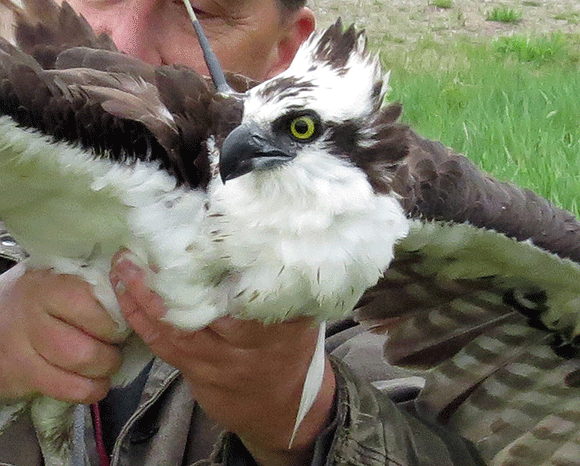 Wausau. In 2014 we had tried trapping at a long-established nest in Groveton, up in the northern portion of the state, but the nest pole, at 65' tall, was just outside the reach of the bucket truck we were using. This year we had a mega-truck and were able to trap our bird in pretty short order. When we arrived, a food transfer had already taken place, so just as we pulled up the female came back into the nest to relieve the male, who had been incubating while the she ate the fish he had delivered. We were concerned that the male might head off somewhere out of sight and thus not been trappable. But, as luck would have it, a Bald Eagle flew by and that got the male's attention. He strafed the eagle a few times and drove it away. We felt that meant our target bird would be attentive around the nest, so up I went up - way up! - in the bucket and set the trap. The female came in quickly and was standing on the noose carpet that I had placed over the nest. The male saw her standing there and landed on her for a quick copulation and then landed on the noose carpet next to her. Unfortunately, he didn't walk around, so he wasn't caught. We did get the female and held on to her for about 30 minutes, when the male came in, landed right on the carpet and was quickly caught. He's named Wausau after the paper company that used to operate a plant at this site. Wausau. In 2014 we had tried trapping at a long-established nest in Groveton, up in the northern portion of the state, but the nest pole, at 65' tall, was just outside the reach of the bucket truck we were using. This year we had a mega-truck and were able to trap our bird in pretty short order. When we arrived, a food transfer had already taken place, so just as we pulled up the female came back into the nest to relieve the male, who had been incubating while the she ate the fish he had delivered. We were concerned that the male might head off somewhere out of sight and thus not been trappable. But, as luck would have it, a Bald Eagle flew by and that got the male's attention. He strafed the eagle a few times and drove it away. We felt that meant our target bird would be attentive around the nest, so up I went up - way up! - in the bucket and set the trap. The female came in quickly and was standing on the noose carpet that I had placed over the nest. The male saw her standing there and landed on her for a quick copulation and then landed on the noose carpet next to her. Unfortunately, he didn't walk around, so he wasn't caught. We did get the female and held on to her for about 30 minutes, when the male came in, landed right on the carpet and was quickly caught. He's named Wausau after the paper company that used to operate a plant at this site. |
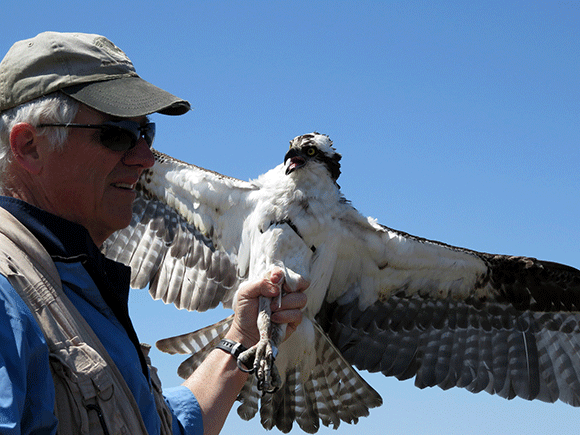 Staddler. On the 21st we headed down to the NH coastline--all 17 miles of it--with the ambitious hopes of deploying 2 transmitters. We worked the Hampton Beach marshes with the help of Dave Weber, who has set up a number of nesting platforms across the marsh. One of these includes the nest where we tagged a juvenile (Weber) back in 2013. We first checked Weber's nest. The female was incubating and there was a male off in the distance, which might or might not have been the male from that nest. We weren't sure, so we motored off to check out other options. The second nest we checked was just a house-keeping nest--well constructed, but no eggs. So we went on to plan C. The third nest we checked, close to the Seabrook Nuclear Power Plant, had a female incubating and a male in close attendance. When we landed near the nest, the female barely moved. We were almost underneath the nest before she even got up off of the eggs. As we set the noose carpet over the nest, the male showed up and was very aggressive, so we were pretty sure we'd catch him. The female was back on the nest and trapped within minutes of our backing away. Once we had the female in hand (she was a really big bird weighing almost 5 pounds (2.2 kg)), we did not have to wait long for the male to land on the noose carpet and get caught. Within 40 minutes he was released and flying out over the marshes with a new transmitter.
The marshes at Hampton Beach were once harvested for salt-marsh hay. Scattered around the marsh are clusters of wooden stakes. These "staddles" were used to keep the bottom of a pile of hay off the ground so the hay wouldn't rot. They are great perches for Ospreys. Each Osprey pair we visited was using the nearest cluster of staddles as a perch. So we decided to name the newly tagged bird "Staddler." (It was a new word for me, too.) Staddler. On the 21st we headed down to the NH coastline--all 17 miles of it--with the ambitious hopes of deploying 2 transmitters. We worked the Hampton Beach marshes with the help of Dave Weber, who has set up a number of nesting platforms across the marsh. One of these includes the nest where we tagged a juvenile (Weber) back in 2013. We first checked Weber's nest. The female was incubating and there was a male off in the distance, which might or might not have been the male from that nest. We weren't sure, so we motored off to check out other options. The second nest we checked was just a house-keeping nest--well constructed, but no eggs. So we went on to plan C. The third nest we checked, close to the Seabrook Nuclear Power Plant, had a female incubating and a male in close attendance. When we landed near the nest, the female barely moved. We were almost underneath the nest before she even got up off of the eggs. As we set the noose carpet over the nest, the male showed up and was very aggressive, so we were pretty sure we'd catch him. The female was back on the nest and trapped within minutes of our backing away. Once we had the female in hand (she was a really big bird weighing almost 5 pounds (2.2 kg)), we did not have to wait long for the male to land on the noose carpet and get caught. Within 40 minutes he was released and flying out over the marshes with a new transmitter.
The marshes at Hampton Beach were once harvested for salt-marsh hay. Scattered around the marsh are clusters of wooden stakes. These "staddles" were used to keep the bottom of a pile of hay off the ground so the hay wouldn't rot. They are great perches for Ospreys. Each Osprey pair we visited was using the nearest cluster of staddles as a perch. So we decided to name the newly tagged bird "Staddler." (It was a new word for me, too.) |
New Juveniles
We tagged two young this year--both in New Hampshire.
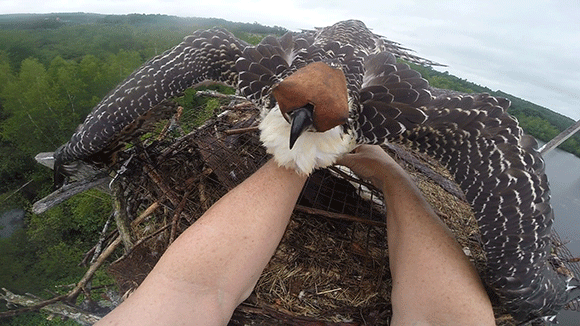 "Juliet" is a young Osprey trapped on 11 August at one of our two "Old Faithful" nests in central NH. This nest in Tilton, not far from the Winnipesaukee River. Juliet may turn out to be Julian. The measurements were ambiguous. If she's not a she, he's a big male. Juliet's father, Donovan, is still wearing his transmitter. We had hoped to trap him and remove the transmitter, but he was having nothing to do with the trap on his nest. We caught Juliet after a wait of not more than 15 minutes. "Juliet" is a young Osprey trapped on 11 August at one of our two "Old Faithful" nests in central NH. This nest in Tilton, not far from the Winnipesaukee River. Juliet may turn out to be Julian. The measurements were ambiguous. If she's not a she, he's a big male. Juliet's father, Donovan, is still wearing his transmitter. We had hoped to trap him and remove the transmitter, but he was having nothing to do with the trap on his nest. We caught Juliet after a wait of not more than 15 minutes. |
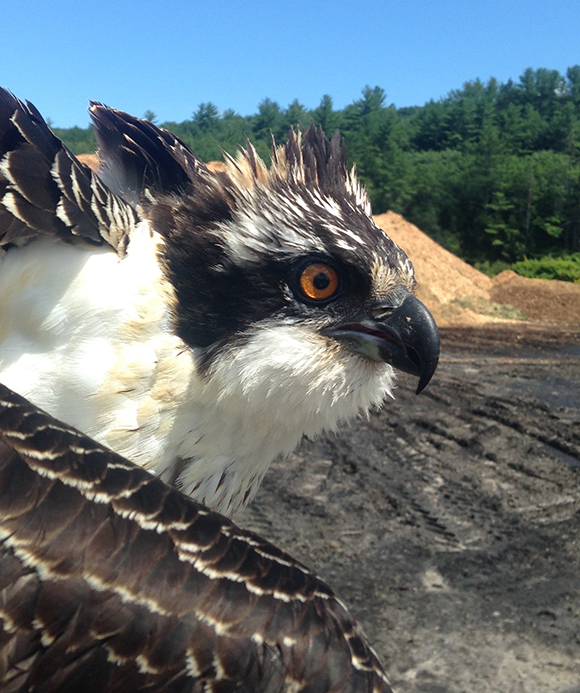 Our second young was tagged at our second New Hampshire "Old Faithful" nest. This one's in Bridgewater, NH. This is the nest where we tagged the adult male "Art" in 2012. In the summer of 2013, we trapped Art and gave his radio to his son, Artoo, while simultaneously trapping and tagging Artoo's brother Bergen. A year later, we tagged his sister Bridget, who settled down in Florida died there in the end of January 2015. Artoo survived both his 18 months in Brazil and his first trip north. He's now cruising around New England, footloose and fancy free.
After waiting around for four hours at Art's nest through a long, hard rain on the afternoon of the 11th, we bailed and came back the next morning. The weather was gorgeous, but the trapping was a bit slow. Two of the three young fledged this year (Art is a very good provider) were noisily begging for good all morning. Art came in twice with fish, but he did not want to land on the nest--he saw the trap this time! So the young followed him downstream to get their fish from him. We did catch the female, whom we've caught before and should know better by now. We finally got "Lizzie" around 11:20. Lizzie weighed in at 1650 g (3.63 lbs), which almost certainly makes her a female. She was named after Liz Hager, a docent, trustee, and long-time supporter of the Squam Lakes Natural Science Center.
(Had it been a male, I would have lobbied to call him "Zorro." The black mask on this bird is really striking.) The day after she was tagged, she took off and two days later she was in Rhode Island, 222 km from her nest. The satellite data showed that she was visiting a nest. A few emails later, we had confirmation that she was indeed mooching fish from the parents at that nest. This behavior is well known when young are flying around near their nest, but the first reported case of long-distance foster parenting. The picture of Lizzie here was taken by Butch Lombardi near her foster nest near Warren, RI, on the 18th of August. We're calling that nest the "Flophouse." Our second young was tagged at our second New Hampshire "Old Faithful" nest. This one's in Bridgewater, NH. This is the nest where we tagged the adult male "Art" in 2012. In the summer of 2013, we trapped Art and gave his radio to his son, Artoo, while simultaneously trapping and tagging Artoo's brother Bergen. A year later, we tagged his sister Bridget, who settled down in Florida died there in the end of January 2015. Artoo survived both his 18 months in Brazil and his first trip north. He's now cruising around New England, footloose and fancy free.
After waiting around for four hours at Art's nest through a long, hard rain on the afternoon of the 11th, we bailed and came back the next morning. The weather was gorgeous, but the trapping was a bit slow. Two of the three young fledged this year (Art is a very good provider) were noisily begging for good all morning. Art came in twice with fish, but he did not want to land on the nest--he saw the trap this time! So the young followed him downstream to get their fish from him. We did catch the female, whom we've caught before and should know better by now. We finally got "Lizzie" around 11:20. Lizzie weighed in at 1650 g (3.63 lbs), which almost certainly makes her a female. She was named after Liz Hager, a docent, trustee, and long-time supporter of the Squam Lakes Natural Science Center.
(Had it been a male, I would have lobbied to call him "Zorro." The black mask on this bird is really striking.) The day after she was tagged, she took off and two days later she was in Rhode Island, 222 km from her nest. The satellite data showed that she was visiting a nest. A few emails later, we had confirmation that she was indeed mooching fish from the parents at that nest. This behavior is well known when young are flying around near their nest, but the first reported case of long-distance foster parenting. The picture of Lizzie here was taken by Butch Lombardi near her foster nest near Warren, RI, on the 18th of August. We're calling that nest the "Flophouse."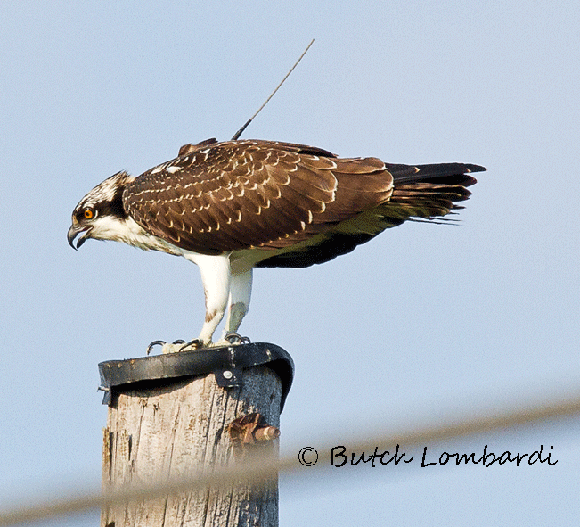 |
 Gundersen. On the 19th of May we trapped at the Ayers Island Dam near Bristol, NH, in the middle of the state. This nest had been our nemesis. We tried two years to catch the male at this nest but were unsuccessful. This year the trapping went quite smoothly. We caught the female first--as is almost always the case--and held onto her while we waited for the male to take over on the nest. This is the same female we've caught twice before as we tried to trap males at this nest. After a pretty long wait, we got our bird. He was named Gundersen in honor of the former manager of the hydroelectric plant. Bob Gundersen was a big fan of the Ospreys and helped out with the old nest-cam that operated here.
Gundersen. On the 19th of May we trapped at the Ayers Island Dam near Bristol, NH, in the middle of the state. This nest had been our nemesis. We tried two years to catch the male at this nest but were unsuccessful. This year the trapping went quite smoothly. We caught the female first--as is almost always the case--and held onto her while we waited for the male to take over on the nest. This is the same female we've caught twice before as we tried to trap males at this nest. After a pretty long wait, we got our bird. He was named Gundersen in honor of the former manager of the hydroelectric plant. Bob Gundersen was a big fan of the Ospreys and helped out with the old nest-cam that operated here. Wausau. In 2014 we had tried trapping at a long-established nest in Groveton, up in the northern portion of the state, but the nest pole, at 65' tall, was just outside the reach of the bucket truck we were using. This year we had a mega-truck and were able to trap our bird in pretty short order. When we arrived, a food transfer had already taken place, so just as we pulled up the female came back into the nest to relieve the male, who had been incubating while the she ate the fish he had delivered. We were concerned that the male might head off somewhere out of sight and thus not been trappable. But, as luck would have it, a Bald Eagle flew by and that got the male's attention. He strafed the eagle a few times and drove it away. We felt that meant our target bird would be attentive around the nest, so up I went up - way up! - in the bucket and set the trap. The female came in quickly and was standing on the noose carpet that I had placed over the nest. The male saw her standing there and landed on her for a quick copulation and then landed on the noose carpet next to her. Unfortunately, he didn't walk around, so he wasn't caught. We did get the female and held on to her for about 30 minutes, when the male came in, landed right on the carpet and was quickly caught. He's named Wausau after the paper company that used to operate a plant at this site.
Wausau. In 2014 we had tried trapping at a long-established nest in Groveton, up in the northern portion of the state, but the nest pole, at 65' tall, was just outside the reach of the bucket truck we were using. This year we had a mega-truck and were able to trap our bird in pretty short order. When we arrived, a food transfer had already taken place, so just as we pulled up the female came back into the nest to relieve the male, who had been incubating while the she ate the fish he had delivered. We were concerned that the male might head off somewhere out of sight and thus not been trappable. But, as luck would have it, a Bald Eagle flew by and that got the male's attention. He strafed the eagle a few times and drove it away. We felt that meant our target bird would be attentive around the nest, so up I went up - way up! - in the bucket and set the trap. The female came in quickly and was standing on the noose carpet that I had placed over the nest. The male saw her standing there and landed on her for a quick copulation and then landed on the noose carpet next to her. Unfortunately, he didn't walk around, so he wasn't caught. We did get the female and held on to her for about 30 minutes, when the male came in, landed right on the carpet and was quickly caught. He's named Wausau after the paper company that used to operate a plant at this site. Staddler. On the 21st we headed down to the NH coastline--all 17 miles of it--with the ambitious hopes of deploying 2 transmitters. We worked the Hampton Beach marshes with the help of Dave Weber, who has set up a number of nesting platforms across the marsh. One of these includes the nest where we tagged a juvenile (Weber) back in 2013. We first checked Weber's nest. The female was incubating and there was a male off in the distance, which might or might not have been the male from that nest. We weren't sure, so we motored off to check out other options. The second nest we checked was just a house-keeping nest--well constructed, but no eggs. So we went on to plan C. The third nest we checked, close to the Seabrook Nuclear Power Plant, had a female incubating and a male in close attendance. When we landed near the nest, the female barely moved. We were almost underneath the nest before she even got up off of the eggs. As we set the noose carpet over the nest, the male showed up and was very aggressive, so we were pretty sure we'd catch him. The female was back on the nest and trapped within minutes of our backing away. Once we had the female in hand (she was a really big bird weighing almost 5 pounds (2.2 kg)), we did not have to wait long for the male to land on the noose carpet and get caught. Within 40 minutes he was released and flying out over the marshes with a new transmitter.
The marshes at Hampton Beach were once harvested for salt-marsh hay. Scattered around the marsh are clusters of wooden stakes. These "staddles" were used to keep the bottom of a pile of hay off the ground so the hay wouldn't rot. They are great perches for Ospreys. Each Osprey pair we visited was using the nearest cluster of staddles as a perch. So we decided to name the newly tagged bird "Staddler." (It was a new word for me, too.)
Staddler. On the 21st we headed down to the NH coastline--all 17 miles of it--with the ambitious hopes of deploying 2 transmitters. We worked the Hampton Beach marshes with the help of Dave Weber, who has set up a number of nesting platforms across the marsh. One of these includes the nest where we tagged a juvenile (Weber) back in 2013. We first checked Weber's nest. The female was incubating and there was a male off in the distance, which might or might not have been the male from that nest. We weren't sure, so we motored off to check out other options. The second nest we checked was just a house-keeping nest--well constructed, but no eggs. So we went on to plan C. The third nest we checked, close to the Seabrook Nuclear Power Plant, had a female incubating and a male in close attendance. When we landed near the nest, the female barely moved. We were almost underneath the nest before she even got up off of the eggs. As we set the noose carpet over the nest, the male showed up and was very aggressive, so we were pretty sure we'd catch him. The female was back on the nest and trapped within minutes of our backing away. Once we had the female in hand (she was a really big bird weighing almost 5 pounds (2.2 kg)), we did not have to wait long for the male to land on the noose carpet and get caught. Within 40 minutes he was released and flying out over the marshes with a new transmitter.
The marshes at Hampton Beach were once harvested for salt-marsh hay. Scattered around the marsh are clusters of wooden stakes. These "staddles" were used to keep the bottom of a pile of hay off the ground so the hay wouldn't rot. They are great perches for Ospreys. Each Osprey pair we visited was using the nearest cluster of staddles as a perch. So we decided to name the newly tagged bird "Staddler." (It was a new word for me, too.) "Juliet" is a young Osprey trapped on 11 August at one of our two "Old Faithful" nests in central NH. This nest in Tilton, not far from the Winnipesaukee River. Juliet may turn out to be Julian. The measurements were ambiguous. If she's not a she, he's a big male. Juliet's father, Donovan, is still wearing his transmitter. We had hoped to trap him and remove the transmitter, but he was having nothing to do with the trap on his nest. We caught Juliet after a wait of not more than 15 minutes.
"Juliet" is a young Osprey trapped on 11 August at one of our two "Old Faithful" nests in central NH. This nest in Tilton, not far from the Winnipesaukee River. Juliet may turn out to be Julian. The measurements were ambiguous. If she's not a she, he's a big male. Juliet's father, Donovan, is still wearing his transmitter. We had hoped to trap him and remove the transmitter, but he was having nothing to do with the trap on his nest. We caught Juliet after a wait of not more than 15 minutes. Our second young was tagged at our second New Hampshire "Old Faithful" nest. This one's in Bridgewater, NH. This is the nest where we tagged the adult male "Art" in 2012. In the summer of 2013, we trapped Art and gave his radio to his son, Artoo, while simultaneously trapping and tagging Artoo's brother Bergen. A year later, we tagged his sister Bridget, who settled down in Florida died there in the end of January 2015. Artoo survived both his 18 months in Brazil and his first trip north. He's now cruising around New England, footloose and fancy free.
After waiting around for four hours at Art's nest through a long, hard rain on the afternoon of the 11th, we bailed and came back the next morning. The weather was gorgeous, but the trapping was a bit slow. Two of the three young fledged this year (Art is a very good provider) were noisily begging for good all morning. Art came in twice with fish, but he did not want to land on the nest--he saw the trap this time! So the young followed him downstream to get their fish from him. We did catch the female, whom we've caught before and should know better by now. We finally got "Lizzie" around 11:20. Lizzie weighed in at 1650 g (3.63 lbs), which almost certainly makes her a female. She was named after Liz Hager, a docent, trustee, and long-time supporter of the Squam Lakes Natural Science Center.
(Had it been a male, I would have lobbied to call him "Zorro." The black mask on this bird is really striking.) The day after she was tagged, she took off and two days later she was in Rhode Island, 222 km from her nest. The satellite data showed that she was visiting a nest. A few emails later, we had confirmation that she was indeed mooching fish from the parents at that nest. This behavior is well known when young are flying around near their nest, but the first reported case of long-distance foster parenting. The picture of Lizzie here was taken by Butch Lombardi near her foster nest near Warren, RI, on the 18th of August. We're calling that nest the "Flophouse."
Our second young was tagged at our second New Hampshire "Old Faithful" nest. This one's in Bridgewater, NH. This is the nest where we tagged the adult male "Art" in 2012. In the summer of 2013, we trapped Art and gave his radio to his son, Artoo, while simultaneously trapping and tagging Artoo's brother Bergen. A year later, we tagged his sister Bridget, who settled down in Florida died there in the end of January 2015. Artoo survived both his 18 months in Brazil and his first trip north. He's now cruising around New England, footloose and fancy free.
After waiting around for four hours at Art's nest through a long, hard rain on the afternoon of the 11th, we bailed and came back the next morning. The weather was gorgeous, but the trapping was a bit slow. Two of the three young fledged this year (Art is a very good provider) were noisily begging for good all morning. Art came in twice with fish, but he did not want to land on the nest--he saw the trap this time! So the young followed him downstream to get their fish from him. We did catch the female, whom we've caught before and should know better by now. We finally got "Lizzie" around 11:20. Lizzie weighed in at 1650 g (3.63 lbs), which almost certainly makes her a female. She was named after Liz Hager, a docent, trustee, and long-time supporter of the Squam Lakes Natural Science Center.
(Had it been a male, I would have lobbied to call him "Zorro." The black mask on this bird is really striking.) The day after she was tagged, she took off and two days later she was in Rhode Island, 222 km from her nest. The satellite data showed that she was visiting a nest. A few emails later, we had confirmation that she was indeed mooching fish from the parents at that nest. This behavior is well known when young are flying around near their nest, but the first reported case of long-distance foster parenting. The picture of Lizzie here was taken by Butch Lombardi near her foster nest near Warren, RI, on the 18th of August. We're calling that nest the "Flophouse."
